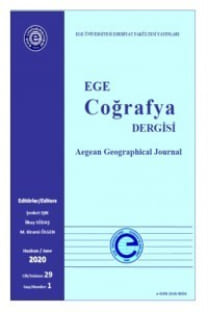DETECTING TRENDS IN FOREST DISTURBANCE AND RECOVERY USING LANDSAT IMAGERY IN TURKEY
Forest disturbance and recovery plays an important role for forest ecosystem management. Understanding the temporal and spatial pattern of these processes is crucial as they affect the carbon flux between atmosphere and biosphere. In this study, the disturbance and recovery processes of forests in Turkey between the years 2000-2010 were detected by Landsat imagery using the LEDAPS Disturbance Index (DI) algorithm. We used validation data collected by field works and achieved 90% overall accuracy with 32 observation points for our resulting map. The comparison with various high resolution data also demonstrated that the DI algorithm can be effectively used to detect forest disturbance and recovery processes in Turkey.Orman bozunumu ve geri kazanımı orman ekosisteminin yönetiminde önemli rol oynar. Biyosfer ve atmosfer arasındaki karbon değişimini etkilemesi bakımından bu süreçlerin zamansal ve mekânsal dokusunu anlamak kritiktir. Bu çalışmada 2000 – 2010 yılları arasında Türkiye’deki ormanların bozunum ve geri kazanım süreçleri Landsat görüntüler ve LEDAPS Disturbance Index (DI) algoritması kullanılarak belirlenmiştir. Arazi çalışmaları sonucunda 32 adet gözlem noktasından toplanan doğrulama verileri ile %90 oranında doğruluk elde edilmiştir. Çeşitli yüksek çözünürlüklü uydu görüntüleri de DI algoritmasının Türkiye’de orman bozunum ve geri kazanım süreçlerinin belirlenmesinde kullanılabileceğini göstermiştir.
Anahtar Kelimeler:
Orman bozunumu, orman gerikazanımı, landsat
DETECTING TRENDS IN FOREST DISTURBANCE AND RECOVERY USING LANDSAT IMAGERY IN TURKEY
Forest disturbance and recovery plays an important role for forest ecosystem management. Understanding the temporal and spatial pattern of these processes is crucial as they affect the carbon flux between atmosphere and biosphere. In this study, the disturbance and recovery processes of forests in Turkey between the years 2000-2010 were detected by Landsat imagery using the LEDAPS Disturbance Index (DI) algorithm. We used validation data collected by field works and achieved 90% overall accuracy with 32 observation points for our resulting map. The comparison with various high resolution data also demonstrated that the DI algorithm can be effectively used to detect forest disturbance and recovery processes in Turkey.
Keywords:
Forest disturbance, Forest recovery, Landsat,
___
- Chambers, J. Q., N. Higuchi, L. M. Teixeira, J. D. Santos, S. G. Laurance, S. E. Trumbore. 2004. “Response of tree biomass and wood litter to disturbance in a Central Amazon forest” Oecologia, 141: 596 – 614.
- Yayın Aralığı: 2
- Başlangıç: 1983
- Yayıncı: Prof. Dr. Şevket IŞIK
